- Home
- Nicholson Baker
Vintage Baker Page 2
Vintage Baker Read online
Page 2
Chapter Two
from THE MEZZANINE
My left shoelace had snapped just before lunch. At some earlier point in the morning, my left shoe had become untied, and as I had sat at my desk working on a memo, my foot had sensed its potential freedom and slipped out of the sauna of black cordovan to soothe itself with rhythmic movements over an area of wall-to-wall carpeting under my desk, which, unlike the tamped-down areas of public traffic, was still almost as soft and fibrous as it had been when first installed. Only under the desks and in the little-used conference rooms was the pile still plush enough to hold the beautiful Ms and Vs the night crew left as strokes of their vacuum cleaners’ wands made swaths of dustless tufting lean in directions that alternately absorbed and reflected the light. The nearly universal carpeting of offices must have come about in my lifetime, judging from black-and-white movies and Hopper paintings: since the pervasion of carpeting, all you hear when people walk by are their own noises—the flap of their raincoats, the jingle of their change, the squeak of their shoes, the efficient little sniffs they make to signal to us and to themselves that they are busy and walking somewhere for a very good reason, as well as the almost sonic whoosh of receptionists’ staggering and misguided perfumes, and the covert chokings and showings of tongues and placing of braceleted hands to windpipes that more tastefully scented secretaries exchange in their wake. One or two individuals in every office (Dave in mine), who have special pounding styles of walking, may still manage to get their footfalls heard; but in general now we all glide at work: a major improvement, as anyone knows who has visited those areas of offices that are still for various reasons linoleum-squared—cafeterias, mailrooms, computer rooms. Linoleum was bearable back when incandescent light was there to counteract it with a softening glow, but the combination of fluorescence and linoleum, which must have been widespread for several years as the two trends overlapped, is not good.
As I had worked, then, my foot had, without any sanction from my conscious will, slipped from the untied shoe and sought out the texture of the carpeting; although now, as I reconstruct the moment, I realize that a more specialized desire was at work as well: when you slide a socked foot over a carpeted surface, the fibers of sock and carpet mesh and lock, so that though you think you are enjoying the texture of the carpeting, you are really enjoying the slippage of the inner surface of the sock against the underside of your foot, something you normally get to experience only in the morning when you first pull the sock on.1
At a few minutes before twelve, I stopped working, threw out my earplugs and, more carefully, the remainder of my morning coffee—placing it upright within the converging spinnakers of the trash can liner on the base of the receptacle itself. I stapled a copy of a memo someone had cc:’d me on to a copy of an earlier memo I had written on the same subject, and wrote at the top to my manager, in my best casual scrawl, “Abe—should I keep hammering on these people or drop it?” I put the stapled papers in one of my Eldon trays, not sure whether I would forward them to Abelardo or not. Then I slipped my shoe back on by flipping it on its side, hooking it with my foot, and shaking it into place. I accomplished all this by foot-feel; and when I crouched forward, over the papers on my desk, to reach the untied shoelace, I experienced a faint surge of pride in being able to tie a shoe without looking at it. At that moment, Dave, Sue, and Steve, on their way to lunch, waved as they passed by my office. Right in the middle of tying a shoe as I was, I couldn’t wave nonchalantly back, so I called out a startled, overhearty “Have a good one, guys!” They disappeared; I pulled the left shoelace tight, and bingo, it broke.
The curve of incredulousness and resignation I rode out at that moment was a kind caused in life by a certain class of events, disruptions of physical routines, such as:
(a) reaching a top step but thinking there is another step there, and stamping down on the landing;
(b) pulling on the red thread that is supposed to butterfly a Band-Aid and having it wrest free from the wrapper without tearing it;
(c) drawing a piece of Scotch tape from the roll that resides half sunk in its black, weighted Duesenberg of a dispenser, hearing the slightly descending whisper of adhesive-coated plastic detaching itself from the back of the tape to come (descending in pitch because the strip, while amplifying the sound, is also getting longer as you pull on it1), and then, just as you are intending to break the piece off over the metal serration, reaching the innermost end of the roll, so that the segment you have been pulling wafts unexpectedly free. Especially now, with the rise of Post-it notes, which have made the massive black tape-dispensers seem even more grandiose and Biedermeier and tragically defunct, you almost believe that you will never come to the end of a roll of tape; and when you do, there is a feeling, nearly, though very briefly, of shock and grief;
(d) attempting to staple a thick memo, and looking forward, as you begin to lean on the brontosaural head of the stapler arm,1 to the three phases of the act—
first, before the stapler arm makes contact with the paper, the resistance of the spring that keeps the arm held up; then, second, the moment when the small independent unit in the stapler arm noses into the paper and begins to force the two points of the staple into and through it; and, third, the felt crunch, like the chewing of an ice cube, as the twin tines of the staple emerge from the underside of the paper and are bent by the two troughs of the template in the stapler’s base, curving inward in a crab’s embrace of your memo, and finally disengaging from the machine completely—
but finding, as you lean on the stapler with your elbow locked and your breath held and it slumps toothlessly to the paper, that it has run out of staples. How could something this consistent, this incremental, betray you? (But then you are consoled: you get to reload it, laying bare the stapler arm and dropping a long zithering row of staples into place; and later, on the phone, you get to toy with the piece of the staples you couldn’t fit into the stapler, breaking it into smaller segments, making them dangle on a hinge of glue.)
In the aftermath of the broken-shoelace disappointment, irrationally, I pictured Dave, Sue, and Steve as I had just seen them and thought, “Cheerful assholes!” because I had probably broken the shoelace by transferring the social energy that I had had to muster in order to deliver a chummy “Have a good one!” to them from my awkward shoe-tier’s crouch into the force I had used in pulling on the shoelace. Of course, it would have worn out sooner or later anyway. It was the original shoelace, and the shoes were old ones my father had bought me two years earlier, just after I had started this job, my first out of college—so the breakage was a sentimental milestone of sorts. I rolled back in my chair to study the damage, imagining the smiles on my three co-workers’ faces suddenly vanishing if I had really called them cheerful assholes, and regretting this burst of ill feeling toward them.
As soon as my gaze fell to my shoes, however, I was reminded of something that should have struck me the instant the shoelace had first snapped. The day before, as I had been getting ready for work, my other shoelace, the right one, had snapped, too, as I was yanking it tight to tie it, under very similar circumstances. I repaired it with a knot, just as I was planning to do now with the left. I was surprised—more than surprised—to think that after almost two years my right and left shoelaces could fail less than two days apart. Apparently my shoe-tying routine was so unvarying and robotic that over those hundreds of mornings I had inflicted identical levels of wear on both laces. The near simultaneity was very exciting—it made the variables of private life seem suddenly graspable and law-abiding.
I moistened the splayed threads of the snapped-off piece and swirled them gently into a damp, unwholesome minaret. Breathing steadily and softly through my nose, I was able to guide the saliva-sharpened leader thread through the eyelet without too much trouble. And then I grew uncertain. In order for the shoelaces to have worn to the breaking point on almost the same day, they would have had to be tied almost exactly the same number of times. But w
hen Dave, Sue, and Steve passed my office door, I had been in the middle of tying one shoe—one shoe only. And in the course of a normal day it wasn’t at all unusual for one shoe to come untied independent of the other. In the morning, of course, you always tied both shoes, but random midday comings-undone would have to have constituted a significant proportion of the total wear on both of these broken laces, I felt—possibly thirty percent. And how could I be positive that this thirty percent was equally distributed—that right and left shoes had come randomly undone over the last two years with the same frequency?
I tried to call up some sample memories of shoe-tying to determine whether one shoe tended to come untied more often than another. What I found was that I did not retain a single specific engram of tying a shoe, or a pair of shoes, that dated from any later than when I was four or five years old, the age at which I had first learned the skill. Over twenty years of empirical data were lost forever, a complete blank. But I suppose this is often true of moments of life that are remembered as major advances: the discovery is the crucial thing, not its repeated later applications. As it happened, the first three major advances in my life—and I will list all the advances here—
shoe-tying
pulling up on Xs
steadying hand against sneaker when tying
brushing tongue as well as teeth
putting on deodorant after I was fully dressed
discovering that sweeping was fun
ordering a rubber stamp with my address on it to make bill-paying more efficient
deciding that brain cells ought to die
—have to do with shoe-tying, but I don’t think that this fact is very unusual. Shoes are the first adult machines we are given to master. Being taught to tie them was not like watching some adult fill the dishwasher and then being asked in a kind voice if you would like to clamp the dishwasher door shut and advance the selector knob (with its uncomfortable grinding sound) to Wash. That was artificial, whereas you knew that adults wanted you to learn how to tie your shoes; it was no fun for them to kneel. I made several attempts to learn the skill, but it was not until my mother placed a lamp on the floor so that I could clearly see the dark laces of a pair of new dress shoes that I really mastered it; she explained again how to form the introductory platform knot, which began high in the air as a frail, heart-shaped loop, and shrunk as you pulled the plastic lace-tips down to a short twisted kernel three-eighths of an inch long, and she showed me how to progress from that base to the main cotyledonary string figure, which was, as it turned out, not a true knot but an illusion, a trick that you performed on the lace-string by bending segments of it back on themselves and tightening other temporary bends around them: it looked like a knot and functioned like a knot, but the whole thing was really an amazing interdependent pyramid scheme, which much later I connected with a couplet of Pope’s:
Man, like the gen’rous vine, supported lives;
The strength he gains is from th’embrace he gives.
Only a few weeks after I learned the basic skill, my father helped me to my second major advance, when he demonstrated thoroughness by showing me how to tighten the rungs of the shoelaces one by one, beginning down at the toe and working up, hooking an index finger under each X, so that by the time you reached the top you were rewarded with surprising lengths of lace to use in tying the knot, and at the same time your foot felt tightly papoosed and alert.
The third advance I made by myself in the middle of a playground, when I halted, out of breath, to tie a sneaker,1 my mouth on my interesting-smelling knee, a close-up view of anthills and the tread marks of other sneakers before me (the best kind, Keds, I think, or Red Ball Flyers, had a perimeter of asymmetrical triangles, and a few concavities in the center which printed perfect domes of dust), and found as I retied the shoe that I was doing it automatically, without having to concentrate on it as I had done at first, and, more important, that somewhere over the past year since I had first learned the basic moves, I had evidently evolved two little substeps of my own that nobody had showed me. In one I held down a temporarily taut stretch of shoelace with the side of my thumb; in the other I stabilized my hand with a middle finger propped against the side of the sneaker during some final manipulations. The advance here was my recognition that I had independently developed refinements of technique in an area where nobody had indicated there were refinements to be found: I had personalized an already adult procedure.
1When I pull a sock on, I no longer pre-bunch, that is, I don’t gather the sock up into telescoped folds over my thumbs and then position the resultant donut over my toes, even though I believed for some years that this was a clever trick, taught by admirable, fresh-faced kindergarten teachers, and that I revealed my laziness and my inability to plan ahead by instead holding the sock by the ankle rim and jamming my foot to its destination, working the ankle a few times to properly seat the heel. Why? The more elegant prebunching can leave in place any pieces of grit that have embedded themselves in your sole from the imperfectly swept floor you walked on to get from the shower to your room; while the cruder, more direct method, though it risks tearing an older sock, does detach this grit during the foot’s downward passage, so that you seldom later feel irritating particles rolling around under your arch as you depart for the subway.
1When I was little I thought it was called Scotch tape because the word “scotch” imitated the descending screech of early cellophane tapes. As incandescence gave way before fluorescence in office lighting, Scotch tape, once yellowish-transparent, became bluish-transparent, as well as superbly quiet.
1Staplers have followed, lagging by about ten years, the broad stylistic changes we have witnessed in train locomotives and phonograph tonearms, both of which they resemble. The oldest staplers are cast-ironic and upright, like coal-fired locomotives and Edison wax-cylinder players. Then, in mid-century, as locomotive manufacturers discovered the word “streamlined,” and as tonearm designers housed the stylus in aerodynamic ribbed plastic hoods that looked like trains curving around a mountain, the people at Swingline and Bates tagged along, instinctively sensing that staplers were like locomotives in that the two prongs of the staple make contact with a pair of metal hollows, which, like the paired rails under the wheels of the train, forces them to follow a preset path, and that they were like phonograph tonearms in that both machines, roughly the same size, make sharp points of contact with their respective media of informational storage. (In the case of the tonearm, the stylus retrieves the information, while in the case of the stapler, the staple binds it together as a unit—the order, the shipping paper, the invoice: boom, stapled, a unit; the letter of complaint, the copies of canceled checks and receipts, the letter of apologetic response: boom, stapled, a unit; a sequence of memos and telexes holding the history of some interdepartmental controversy: boom, stapled, one controversy. In old stapled problems, you can see the TB vaccine marks in the upper left corner where staples have been removed and replaced, removed and replaced, as the problem—even the staple holes of the problem—was copied and sent on to other departments for further action, copying, and stapling.) And then the great era of squareness set in: BART was the ideal for trains, while AR and Bang & Olufsen turntables became angular—no more cream-colored bulbs of plastic! The people at Bates and Swingline again were drawn along, ridding their devices of all softening curvatures and offering black rather than the interestingly textured tan. And now, of course, the high-speed trains of France and Japan have reverted to aerodynamic profiles reminiscent of Popular Science cities-of-the-future covers of the fifties; and soon the stapler will incorporate a toned-down pompadour swoop as well. Sadly, the tonearm’s stylistic progress has slowed, because all the buyers who would appreciate an up-to-date Soviet Realism in the design are buying CD players: its inspirational era is over.
1Sneaker knots were quite different from dress knots—when you pulled the two loops tight at the end, the logic of the knot you had just created became untraceable; w
hile in the case of dress-lace knots, you could, even after tightening, follow the path of the knot around with your mind, as if riding a roller coaster. You could imagine a sneaker-shoelace knot and a dress-shoelace knot standing side by side saying the Pledge of Allegiance: the dress-shoelace knot would pronounce each word as a grammatical unit, understanding it as more than a sound; the sneaker-shoelace knot would run the words together. The great advantage of sneakers, though, one of the many advantages, was that when you had tied them tightly, without wearing socks, and worn them all day, and gotten them wet, and you took them off before bed, your feet would display the impression of the chrome eyelets in red rows down the sides of your foot, like the portholes in a Jules Verne submarine.
Chapter Three
from THE MEZZANINE
Progress like that did not come again until I was over twenty. The fourth of the eight advances I have listed (to bring us quickly up to date, before we return to the broken shoelaces) came when I learned in college that L. brushed her tongue as well as her teeth. I had always imagined that toothbrushing was an activity confined strictly to the teeth, possibly the gums—but I had sometimes felt fleeting doubts that cleaning merely those parts of your mouth really attacked the source of bad breath, which I held to be the tongue. I developed the habit of pretending to cough, cupping my hand over my lips to sniff my breath; when the results disturbed me, I ate celery. But soon after I began going out with L., she, shrugging as if it were a matter of common knowledge, told me that she brushed her tongue every day, with her toothbrush. I shivered with revulsion at first, but was very impressed. It wasn’t until three years had passed that I too began brushing my own tongue regularly. By the time my shoelaces broke, I was regularly brushing not only my tongue but the roof of my mouth—and I am not exaggerating when I say that it is a major change in my life.

 House of Holes
House of Holes Checkpoint
Checkpoint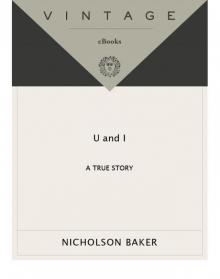 U and I
U and I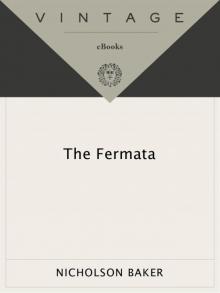 The Fermata
The Fermata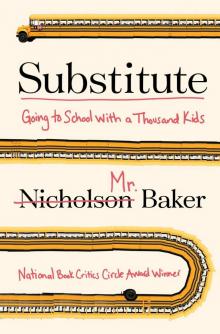 Substitute
Substitute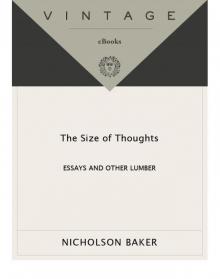 The Size of Thoughts
The Size of Thoughts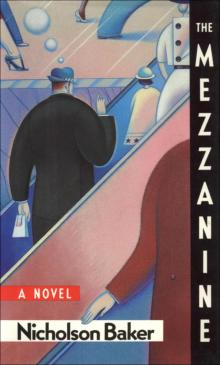 Mezzanine
Mezzanine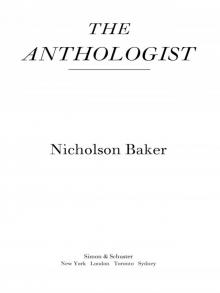 The Anthologist
The Anthologist Traveling Sprinkler
Traveling Sprinkler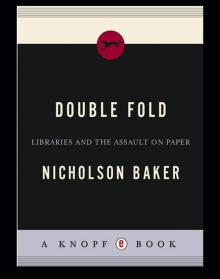 Double Fold
Double Fold The Everlasting Story of Nory
The Everlasting Story of Nory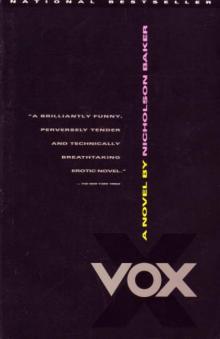 Vox
Vox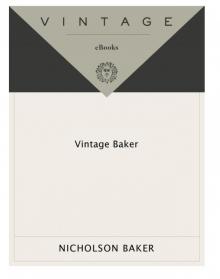 Vintage Baker
Vintage Baker A Box of Matches
A Box of Matches